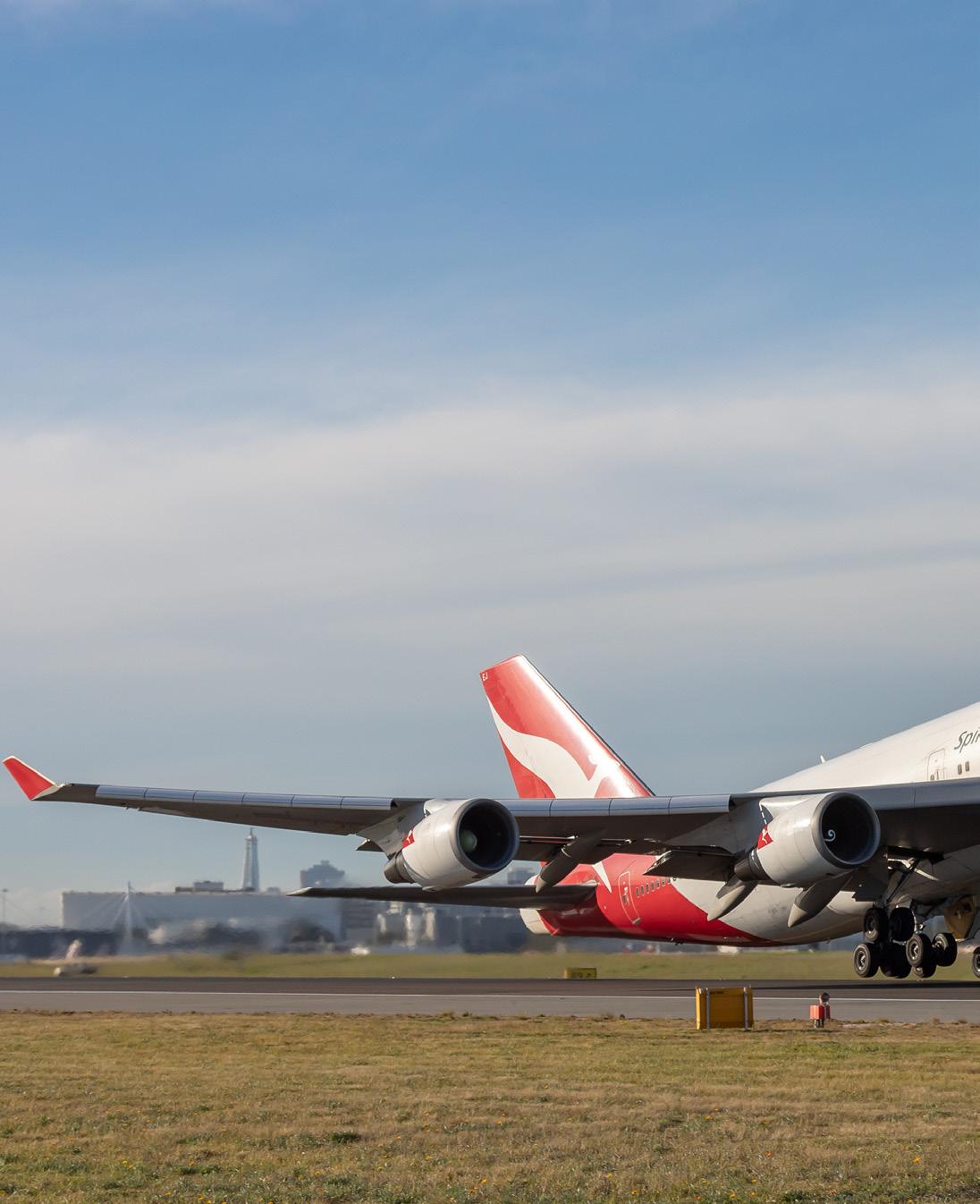
21 minute read
JUMBO FINALE Farewell to the Qantas 747
from ADBR JUL-AUG 2020
by adbr5
AEROSPACE A JUMBO FINALE
A farewell fit for a Queen
Advertisement
BY OWEN ZUPP
After 49 years of service, the final Qantas Boeing 747 leaves Australian soil for the final time, as VH-OEJ sets course for its final resting place in the US. KURT AMS A hallmark of the aerospace industry is its dynamic and ever-evolving nature. A little over a century has passed since the Wright Brothers made their momentous flights at Kitty Hawk in frail machines of rag and tube, and now we have private ventures flying to space stations and aircraft that can fly farther and faster than we once not dared to imagine.
Conversely, such a rate of advancement results in a sparsity of longevity. Today’s technology is often gone tomorrow.
There have been some exceptions to the rule. The venerable Douglas DC3/C47 Dakota, the Boeing B-52 Stratofortress, and the Bell UH-1 ‘Huey’ and their many sub-variants are just a few that come to mind – survivors of generational changes that have seen their contemporaries long consigned to boneyards and scrappers. At their core exists a sound design, yet with time such machines develop something more by evoking emotion in their operators and enthusiasts alike.
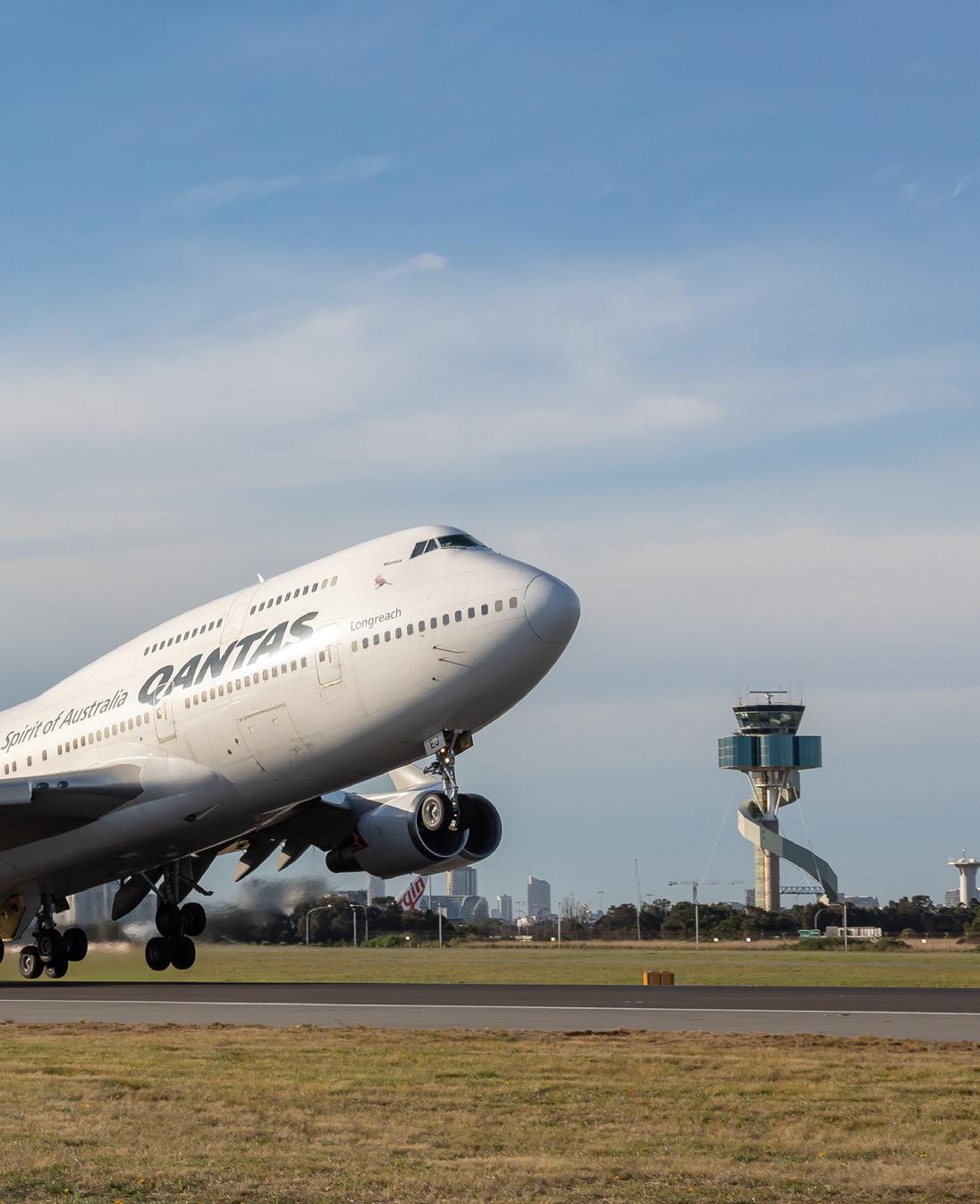
This emotion was no more evident than in July’s retirement of the final QANTAS Boeing 747 after nearly 50 years of service with the airline. Spectators lined the runways and various other vantage points to wave goodbye, and a lucky few were privileged to take one last flight before VHOEJ was relegated to history.
In a final salute, the aircraft set course for Los Angeles and ultimately the Mojave Desert in a departure that had Sydneysiders craning their necks to the sky, and the world fascinated by what was etched upon their computer screens. It was a farewell to remember for many, and the culmination of incredible planning from a small team.
LONG MAY SHE REIGN Like so many great stories, the Boeing 747 emerged from an unlikely combination of circumstances. Despite Boeing’s loss to Lockheed for the contract to build a massive military transport aircraft for the USAF in 1965 – which resulted in the Lockheed C-5A Galaxy – certain design features and technologies from Boeing’s bid were refined and retained.
There was the emerging high-bypass engine technology that could be adapted to an airliner and, like their successful 707 line, the military contract had seen the rise of Boeing’s swept-wing aircraft as airliner contenders. Additionally, to allow the loading of equipment through the nose, the flight deck was positioned atop the cargo area.
As Boeing re-directed its focus to commercial air travel, the industry was witnessing unprecedented passenger numbers and lower airfares. The 707 had generated a revolution of its own, but PanAm founder Juan Trippe was keen to see an aircraft of far higher capacity take to the increasingly crowded skies to further drive down fares and significantly increase passenger numbers.
Even so, Trippe ultimately saw the rise of supersonic air travel as the future for passengers, meaning that his vision of a giant of the sky would need to provide for freighter conversion as it was superseded by speed. In December 1965, Juan Trippe and Boeing’s Bill Allen signed an initial order for 25 aircraft, in a US$25 million deal that had the potential to financially cripple both companies.
From the outset, the Boeing 747 had dimensions that dwarfed its predecessor, the 707. To be offered in both passenger and freight roles, the original 747 was over 220 feet long with a tail over 62 feet high, an increase of more than 50 per cent over the 707 in both aspects. So large was the design that Boeing needed to build a new facility at Everett in Washington state to cater for the 747 and, in doing so, constructed the world’s largest building by volume.
Moving from the 737 team, Joe Sutter was assigned the role of Chief Engineer for the development of the project, and history has come to know him as the ‘Father of the 747’. Along with a team of 50,000 at Boeing, they came to be known as ‘The Incredibles’ as they sought to create a commercial airframe and engine combination, the likes of which had not been seen before. But with the backdrop of the United States’ space program, it was a time when anything seemed possible.
In February 1969, the faith of so many was repaid when the prototype 747 first took to the skies, only five months before man stepped on the moon.
The 747 caught the interest of QANTAS very early in its genesis, with the Australian airline placing then changing its initial order for the 747- 100 to four of the longer range 747-200s in 1967. The first QANTAS 747 arrived in August 1971, flying its first revenue service to Perth and Singapore a month later. It was the beginning of a relationship between airline and aircraft that would see QANTAS operate the 747 in a range of variants. Ultimately the airline would order 60 747s, from the -100s, which QANTAS leased, to the ‘Classic’ -200s and -300s, the distinctively shortened 747SP or Special Performance version, the -400s, and -400ER (Extended Range) models.
It was a union that endured for almost half a century and, for a period, marked QANTAS as the only all-747 airline in the world. As the landmark of 50 years approached, it was a sunset retirement that was to be celebrated by QANTAS for their airliner that democratised global air travel. That was until the COVID pandemic landed in 2020. BEST LAID PLANS The retirement of the Boeing 747 from the QANTAS ranks was inevitable. While it was still loved by the travelling public and its crews alike, its generation was being replaced by the efficiency of the dawn of newer twin-jets, such as the Boeing 787 Dreamliner and the Airbus A350. QANTAS’s ambitious ‘Project Sunrise’ had made its first appearance above the horizon, aspiring to non-stop flights of a duration that was even beyond the commercial reach of the 747-400ER. The time had come for the 747 to exit with grace.
The retirement of an aircraft fleet is a complex, staged process. For the QANTAS 747s, it meant a gradual reduction of the network it was flying as the aircraft were progressively flown to the US where they would be retired to a boneyard and sourced for their well-maintained and increasingly scarce components. Or in the case of the airline’s 747-400 VH-OJU, rebirthed as an engine test-bed for Rolls Royce.
Concurrently, the number of crew would be reduced and retrained, and assigned to other fleets until the final airframe’s departure would see the last pilots relocated through a reduction-in-number, or RIN process.
The plan was in place about a final hurrah in March 2021, offering the 747 for one final season of memorable Antarctica charters and adding the symmetry of 50 years of service from 1971–2021. A full schedule of events marking the longevity and loyal service of the 747 in QANTAS colours was in the planning when the global pandemic cancelled the parade.
With the initial outbreak, the remaining fleet was removed from service on an accelerated timeframe and ferried to the Mojave Desert. In the first instance, this repositioning was for storage but, with every passing week and then month, the chance of the 747 ever returning to service diminished rapidly.

The sky art ‘Roo’ that captured the imagination of so many - the result of meticulous navigation planning. OWEN ZUPP
A fitting final salute ... the water cannon farewell on taxi to the runway at Sydney Airport. SET H JAWORSKI

The final arrivals of aircraft were greeted by news coverage as media and public sense of the end grew.
At the same time, the crew of the final flight had been selected and called to the simulator to confirm currency and proficiency. This included those pilots that would occupy the control seats for the last, unfamiliar sector into the boneyard at the Mojave Air and Space Port, about 140km north of Los Angeles.
One by one, the QANTAS 747 fleet departed Australian shores, all keenly tracked by aviation enthusiasts around the world. By late June, only the 747-400ER, VH-OEJ Wunala remained on Australian soil. Speculation began to grow in the media about the final departure date with a growing sentiment of regret that the last QANTAS 747 would ‘go gently into that good night’.
With the airline in its centenary year and recognising the significance of the final flight, QANTAS Manager of Fleet Operations – Boeing 747, Captain Owen Weaver – successfully sought a stay of execution for the aircraft to provide a more fitting send-off. The concept was embraced by the Executive Team led by QANTAS International CEO Tino La Spina, although time was running short and there remained the constant spectre of closed borders preventing any crew from easily returning to Australia.
On June 25, the rumours were confirmed as part of the major QANTAS announcement outlining its future in the face of COVID: the remaining Boeing 747s were to be retired immediately. Soon after, the airline announced three farewell flights and a final departure to be remembered. The wheels were set in motion. FOND FAREWELLS In so many ways, the 747 was the peoples’ aeroplane. It had opened up the world to Australians on a previously unknown scale, through memories of amazing holidays and emotional family reunions. If there was a poignant moment in an Australian life beyond her shores, the chance was great that the 747 had made that possible. With this in mind, QANTAS wanted to share the moment with the people, albeit with strict COVID-19 protocols in place.
A plan was drafted with one each of the farewll flights departing Sydney, Brisbane, and Melbourne. But with the tenuous state of its borders and public health situation, the first casualty was the Melbourne flight which had to be moved to Canberra.
With the harsh reality of costs hitting all airlines, the flights were brought to life through a skeleton of staff being stood up from their relative hibernation to attend to every issue from media relations, to engineering, flight planning, crewing, and so much more. Even assigning the flight number of QF747 presented a significant challenge within the airline’s IT systems. However, it soon became apparent that the flights meant a great deal to staff and the QANTAS family came together to make the event happen.
A lottery system was devised to allow some of that family to gain a seat on their airline’s final 747 flights, while other seats were sold online to offset some of the costs involved and raise funds for two aviation museums. The demand far outweighed availability, and the tickets sold in minutes. A good
many more flights could have been sold, but the timeframe was already in place.
Each of the three flights was blessed by clear skies. The atmosphere was festive, although tinged with emotion as passengers gathered in gate lounges and exchanged memories of the ‘Queen of the Skies’. Past employees in retro uniforms, aviation enthusiasts and current crew mingled and posed for photos. Commemorative QANTAS bags and memorabilia were a treasured part of the experience, but the flights would prove to be the ultimate memory.
Socially-distanced and COVID-conscious, passengers boarded their flights, seen off by pilots offering hand sanitiser in a subtle but visible reminder of aviation and the world’s current concerns. But those concerns quickly melted away each time that the 747 pushed back and took to the skies. Over Sydney, the harbour swept by beneath, while Brisbane’s skyline and coastline provided a stark contrast to the snow-capped ranges and circular roadways of the nation’s capital.
Onboard, conversation and champagne flowed, while landings were met with applause, and disembarkations with tears. To conclude each event, the crowds gathered beneath her swept wings and towering tailplane for a final photograph, or simply to take in her graceful form in their mind’s eye.
Still, the ‘Queen of the Skies’ had one more statement to make and those plans were well underway beneath a veil of secrecy.

PLANNING AN ADIEU & THE ROO VH-OEJ flies up Sydney Harbour on the first of its When the farewell flights were conceived, so too was two farewell passes before the plan to make the departure of OEJ a flight for heading south to overfly VHOJA at Albion Park. all to remember. Central to the departure were three SETH JAWORSKI key elements – a flypast of Sydney harbour, a salute to the record-breaking and first 747-400, VH-OJA, which is now in residence at the HARS Museum at Shellharbour Airport, and ‘sky art’ in the form of the QANTAS kangaroo.
The entire exercise had to be founded on a basis of safety and, to that end, each component was planned, trained, and executed according to a safety plan that needed to gain approval from CASA. Far from simply conceiving a route, myriad elements had to be addressed.
Unlike the farewell flights, OEJ would be operating at a significantly heavier weight, and flight margins needed to be considered accordingly. The crew would be in attendance at the event before departure and, with substantial flight time, potential fatigue issues needed to be addressed and satisfied. Security ‘The Queen of the Skies considerations and customs clearance at the QANTAS had one more statement to make and those plans hangar, rather than the international terminal had to be organised. were well underway under a veil of secrecy’
A previous farewell under stormy skies. Qantas has been retiring its 747s progressively, and VH-OEB was the oldest remaining -400 series 747 in the fleet when it was retired in 2019. NIGEL COGHLAN Calculating the weight and balance of the aircraft and loading it accordingly, with a cargo of many pets bound for the US … the list went on.
Captain Weaver drew together teams from all areas within the airline. Matthew Bouttell as manager of Air Traffic Management was responsible for organising the complex airways clearances, as well as designing the Temporary Restricted Area (TRA) that was needed to safely overly the HARS Museum outside controlled airspace.
The navigation team led by Cass Moeller and Jevan Wong was tasked with tailoring the existing flight planning system to incorporate the many complex waypoints involved in drawing the sky art and calculating the fuel requirements.
Catering was needed to provide a non-standard configuration of meals for the crew, and the refuellers had to load the aircraft to maximum limits without fuel overflowing through the surge tanks. The Airports Team and Sydney Airports Corporation Limited (SACL) had to confirm the pavement strength in the alley way from the hangar where OEJ would taxi at a weight of 368,000 kg.
The QMET section was consistently providing weather and upper wind forecasts, as the sky art and flypasts were weather-dependent upon predefined parameters – another reason for the secrecy. Furthermore, they were continually organising weather forecasts for Mojave as they are not normally provided.
The engineering team had to prepare the aircraft for international flying once again, ground testing the autopilot for auto-land capability, and configuring the cabin for its ultimate state when finally parked in the boneyard, among many other tasks. The event itself at QANTAS Hangar 96 fell on the shoulders of the QANTAS Events Team,
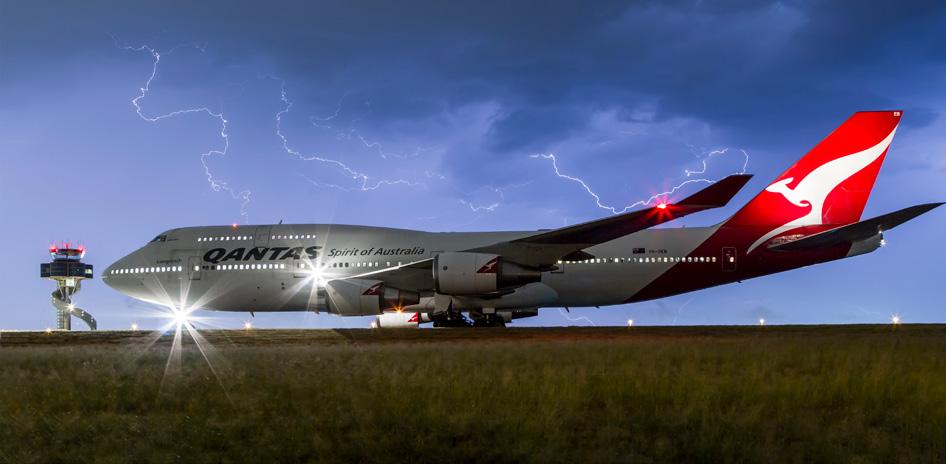
while the associated media was managed by the Communications Department, led by Amanda Bolger.
The crew for the flight had been selected weeks before. Sharelle Quinn, the first female QANTAS Captain, and the airline’s most senior 747 Captain Ewen Cameron, would fly the initial departure. Also, onboard would be Captains Owen Weaver and Greg Fitzgerald, First Officer Quin Ledden, and your writer, Second Officer Owen Zupp. Together, the crew had more than 124,000 hours of flight experience, including more than 78,000 hours on the 747.
The centrepiece of the departure was set to be the sky art kangaroo, yet when Captain Weaver first conceived the idea, he wasn’t even sure if it was possible. In the first instance, he overlaid the outline in Google Earth Pro and generated a series of waypoints. As these were expressed in decimal points, all 75 had to be converted into latitudes and longitudes. Scaling the sky art was the next challenge. Turns had to be of a radius within the capability of the heavily-laden 747 and of a size and location to be seen by the flight tracking ‘apps’ without dropping out of ADS-B coverage.
Captain Weaver flew a series of secretive simulator sessions with Captain ‘Marty’ Gardiner in a range of configurations to trial the kangaroo. Finally, remaining below 20,000 feet so that flaps could be extended and then utilising Flaps 20 and the autopilot, all turns within the ‘Roo’ could be safely flown.
With the approval and co-operation of the Royal Australian Air Force, the airspace was made available. The flight crew then made a series of visits to the flight simulator where the various elements of the departure were rehearsed as well as the arrival into Mojave. The scene was finally set.
FAREWELL TO THE QUEEN The QANTAS Hangar 96 was abuzz with gathered guests and dignitaries. CEO Alan Joyce spoke of the significance of the 747 to the airline’s history, and First Officer Geoff Cowell recited a moving poem dedicated to his steed.
Media moved about busily, and all present were invited to sign their names and a message on the belly of Wunala. The numbers were scaled down due to COVID, but the appreciation of a fitting farewell was not lost amid the excitement.
The crew mingled with the guests, with Captains Weaver and Fitzgerald discreetly sneaking away to enter and cross-check the 75 waypoints of the ‘Roo’ sky art into the Flight Management Computer (FMC). It had been hoped that the hard work of the navigation and “Constellation” flight planning teams would allow an automatic uploading of the waypoints However, an earlier trial had shown it to be beyond the capability of the 747’s FMC. With the final words and waves completed, the crew took their stations and after pushback and an intermediate stop to finalise loading the aircraft, we were underway.
The initial departure involved a turn to the west before returning to overhead Sydney Airport, so Runway 16 Right was offered up by Air Traffic Control to maximise separation from the Bankstown Airport airspace. The subsequent taxi out was a tour of water cannon salutes, media helicopters, and hundreds of gathered well-wishers at the ‘Shep’s Mound’ spotters park, in front of which Captain Quinn paused QF7474 – again, a flight number that had presented an IT challenge.
As the thrust levers moved up, the flight deck was focused on the task rather than the emotion. Over the next hour, they managed the 747’s extensive radius of turn to cross the coast at the designated points, aware of the gatherings beneath. The sight of the Harbour Bridge and Opera House passing 1,500 feet below were spectacular, as a lap along the Parramatta River terminated with a reversal turn and a second overflight.
Air Traffic Control wished them well as the aircraft tracked coastal to Shellharbour where OJA and a substantial crowd looked skyward. The radio broadcasts from Wunala were met with a response and tribute for those below. A pass along the runway, a left turn out to sea and the final QANTAS 747 had departed Australia.
Unknown to the crew, more than a quarter of a million people were watching the track they were flying as they approached the commencement of the sky art. But only when the various wind and weather parameters were confirmed was the final go-ahead decided upon and the QANTAS Integrated Operations Centre (IOC) advised to release the well-kept secret.
Some thought the initial turn was the 747 returning to Australia for some reason, but it soon became apparent there was something special in store. For the next 90 minutes the ‘Queen of

the Skies’ etched her goodbye in the sky, accelerating along the extended lines of the kangaroo’s back and tail and decelerating and extending flaps to manoeuvre around the paws and other tighter turns. By the time the art was complete, the sun had set, and so too had QANTAS 747 operations in Australian airspace.
Now the Pacific beckoned for one final time.
ONE LAST HOP The arrival into Los Angeles for the crew was somewhat surreal. Familiar with the rapid-fire radio transmissions and multiple targets on the Traffic Collision Avoidance System (TCAS), the COVID-affected airwaves and airspace were uncharacteristically and eerily quiet.
When Captain Quinn finally brought Wunala to a halt, a walkway was extended and the crew met by mask-wearing staff as they fitted their own. At the airport’s perimeter fence and LAX’s famous but unofficial Imperial Hill spotters park, another crowd of enthusiasts and expats had gathered to welcome the aircraft and crew, some waving Australian flags.
After nearly 48 hours locked down in their Manhattan Beach apartments, the crew readied for the final 20-minute sector to the Mojave Air and Space Port. Captain Cameron would fly in command
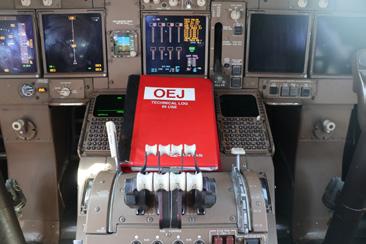
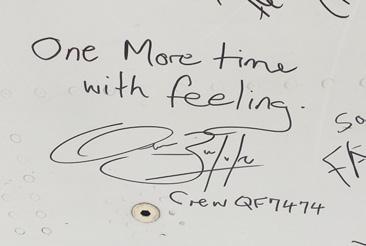
Top: Author Owen Zupp and wife Kirrily, also a Qantas 747 pilot, volunteered their time in a ground role for the farewell flights from Sydney and Canberra. TONY LUCAS
Centre: At rest - the final shutdown of VH-OEJ with tech log at Mojave. OWEN ZUPP
Bottom: Owen’s message on the underside of OEJ speaks volumes. OWEN ZUPP
‘To be part of such an event was a privilege with Captain Fitzgerald alongside him in a fitting end to their substantial that was not lost upon the crew’ QANTAS careers. Both pilots had rehearsed the sector in the simulator numerous times, aware of the proximal terrain and the nearby airspace of the famous Edwards AFB facility and other sensitive military facilities. The QANTAS Base Manager at Los Angeles Airport had something special in mind to say goodbye - an Australian style barbeque of sausages, bacon, and eggs to the accompaniment of I Still Call Australia Home being sung by the present staff was a very moving moment. Two dedicated 747 cakes were cut to a backdrop of QANTAS banners and pedal car, and the sense of a QANTAS family was as strong as it could possibly be. One final walkaround inspection, one final engine start and one last taxi out for takeoff, this time at a weight of only 228,000 kg. Water cannons again said goodbye as hundreds of QANTAS staff and other airport workers lined the taxiway, and emergency vehicles ahead and on the flanks escorted the Boeing 747 to the runway’s end. A last farewell from Air Traffic Control and a clearance to takeoff, and the aircraft took to the skies from VH-OEJ leaves Sydney for its final farewell against the RWY 25L beneath Captain Cameron’s hands as backdrop of a stark reminder helicopters filmed and the people below waved. of the pandemic toll on commercial aviation. A right turn and climb to only 13,000 feet, the NIGEL COGHLAN 747 cut through the clear air, crossing the coast

overhead Malibu and set course for the desert and Mojave. Numerous light aircraft populated the TCAS, possibly catching one last look. To stay well clear, the crew brought the 747 into a sweeping left orbit near Mojave airfield until the sky was empty once again. Joining overhead, a visual circuit was flown, and the runway loomed ahead. The long black strip grew larger until Captain Cameron finally eased Wunala to earth for the final time.
Aside from the mandatory checks and calls, the flight deck was quiet as the aircraft was taxied and parked in a line astern to three QANTAS 747 sisters already in residence. The crew each took their turn at shutting down an engine and putting OEJ to bed for the final time. Only then, with the task finally complete, did the focus shift to reflection on what this all meant.
On the ground, the crew were met by more media and answered questions beside the now quiet 747, although it was impossible to ignore the sad sight of hundreds of scrapped airliner hulks on the far side of the airfield. Perhaps it was those mixed emotions, perhaps it was a weariness, but very few words were spoken on the two-hour bus ride back to their accommodation in Los Angeles.
Undoubtedly, it was the realisation that this was the end of an era and, unfortunately for some, a career. To be part of such an event was a privilege that was not lost upon the crew. And it was an absolute honour to farewell the ‘Queen’.








